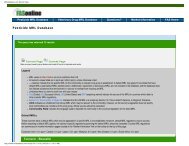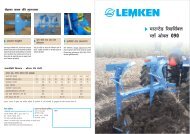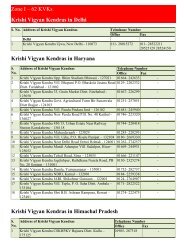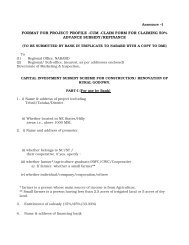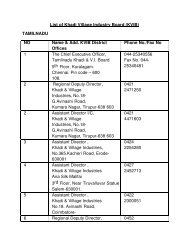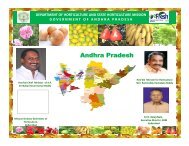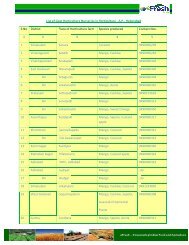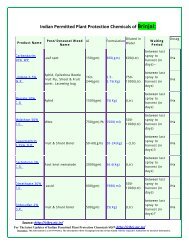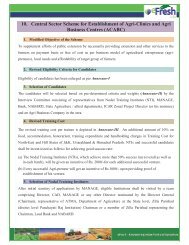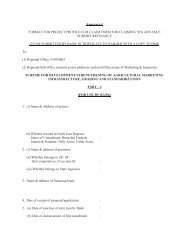Flowchart for Pomegranate Cultivation - Efresh India
Flowchart for Pomegranate Cultivation - Efresh India
Flowchart for Pomegranate Cultivation - Efresh India
You also want an ePaper? Increase the reach of your titles
YUMPU automatically turns print PDFs into web optimized ePapers that Google loves.
eFresh – Empowering <strong>India</strong>n Agriculture<br />
<strong>Flowchart</strong> <strong>for</strong> <strong>Pomegranate</strong> <strong>Cultivation</strong><br />
Selection of site<br />
Soil and water testing<br />
Preparation of land<br />
Layout – Alignment, Digging of pits etc.<br />
Selection of planting materials from the<br />
nursery.<br />
Planting in the main yield<br />
Care after planting – watering, manuring<br />
and plant protection<br />
Training and pruning<br />
Manuring<br />
Irrigation<br />
Inter cultivation/Inter Culture<br />
Inter cropping<br />
Cropping<br />
Plant protection<br />
Harvesting – Harvest indices, Harvesting<br />
and care after harvesting<br />
Sorting of Fruits, Transport to Pack<br />
Houses/Markets.
eFresh – Empowering <strong>India</strong>n Agriculture<br />
1. Selection of site<br />
2. Soil and water testing<br />
3. Preparation of land<br />
4. Layout – Alignment, Digging of pits etc.<br />
5. Selection of planting materials from the nursery.<br />
6. Planting in the main yield<br />
7. Care after planting – watering, manuring and plant protection<br />
8. Training and pruning<br />
9. Manuring<br />
10. Irrigation<br />
11. Inter cultivation/Inter Culture<br />
12. Inter cropping<br />
13. Cropping<br />
14. Plant protection<br />
15. Harvesting – Harvest indices, Harvesting and care after harvesting<br />
16. Sorting of Fruits, Transport to Pack Houses/Markets.
eFresh – Empowering <strong>India</strong>n Agriculture<br />
1. Selection of Site<br />
A Brief in Right into each of the above Operation<br />
• Select deep loamy/alluvial soil.<br />
• Also select soil with medium fertility.<br />
• Site should be not above 1800m above mean sea level.<br />
• Requires hot and dry climate during the period of fruit development and ripening.<br />
• The optimum temperature <strong>for</strong> fruit development is 18<br />
• The Plant Bears well under irrigation so there should be adequate supply of irrigation water Good<br />
quality.<br />
2. Soil and water Testing<br />
• To Know the suitability of soil , Its Fertility and PH Whether the soil and soil depth meet the hop<br />
requirement<br />
• Water testing is e to know quality of water of the crop or the amendment to suit pomegranate crop.<br />
3. Preparation of Land<br />
• 2-3 deep Plouighing to get fine Tilt<br />
• Level the land.<br />
• Mark the Planting position as per the recommended<br />
4. Lay-out – Alignment, Digging of pits etc.<br />
• Adopt a Spacing o 5x5m in Square System of Planting.<br />
• Pintsize 60x60x60 cm<br />
• Refill the pith with Top soil mixed with 20-25Kg F&M/Comport + 1Kg SSP on basal Laying of Dried<br />
Leaves + Dried Gram.<br />
• Slow the soil to settle and if any depression appeals Add Soil to Bring the soil to the surface level.
eFresh – Empowering <strong>India</strong>n Agriculture<br />
5. Selection of manting material from the nursery<br />
• Select well nested hand wood cuttings of one year<br />
• Select healthy, robust Plath free from Pests and diseases Particulate Bacterial light<br />
6. Manting in the mainfield<br />
• Best time the planting in the are set of south west mansion (June-July) or February of irrigation futility<br />
are available.<br />
• Cut open the polybage without disturbing the root system in the ball of earth.<br />
• Set the Plant in the hole scooped out in the Center of the Pit.<br />
• Press the soil around the plant to remove air pockets in the soil.<br />
• Irrigate/water immediately in a bring prepared around the plant.<br />
• Stake the plant the support and to a gold tappling.<br />
7. Care after planting-watering, manuring and plant protection<br />
• Water /irrigate the newly set plants at uni<strong>for</strong>m intervals <strong>for</strong> better establishment and survival<br />
• Continue watering particularly during only periods<br />
• Apply nitrogen in the <strong>for</strong>m of urea at bi monthly intervals to push up growth, with recommended dose.<br />
• Protect the plant from pests and diseases, particularly bacterial blight with suitable pesticides.<br />
8. Training and pruning<br />
• From second year onwards, established plants may be trained to multiple stem system of training.<br />
• Regular pruning is necessary , remove water sources, weak crotches, dead and died, twigsa, criss-crossing<br />
• Shoots and old spun ,after harvest of fruits every time<br />
• Apply bordaux pest to the cut end<br />
9. Manuring<br />
• Follow the region wise recommended manorial schedule<br />
• Apply manuar in the beginning of monsoon <strong>for</strong> decomposition and fertilizer at frequent intervals in split doses<br />
• Apply the manure and fertilizer in a trench dug around the plant at a distance.<br />
• Irrigate immediately after manuring.
eFresh – Empowering <strong>India</strong>n Agriculture<br />
10. Irrigation<br />
• Though drought resistant pomegranate has to be irrigated <strong>for</strong> commercial yields.<br />
• Regular irrigation from flowering till harvesting is necessasary otherwise flowers drop and fruits show cracking.<br />
• In winter the interval may be 8-10 days and in summer 4-6 days.<br />
11. Inter cultivation/inter culture<br />
• Shallow cultivation in the inter spaces to suppress the weeds, to improve cultivation, infilteration &conservation<br />
of soil moisture<br />
• Inter cultivation by ploughing may be done as per the bahar preferred<br />
• Mulch the basin <strong>for</strong> conservation of moisture &suppress the weeds during the period<br />
12. Inter cropping<br />
• During the initial 3-4 years suitable inter crops like vegetables flower crops &legumes<br />
13. Cropping-flowering<br />
• Starts cropping in 3-4 year planting<br />
• Produces 3 crops in a year under tropical conditions<br />
• Choose one of them and adopt suitable cultural practices<br />
14. Plant protection<br />
• Important insect pests are pomegranate butterfly, bark eating catter pillar, sap sucking insects(apids, mely bugs,<br />
thrips)<br />
• Important diseases are bacterial leaf spot (bacterial blight)fruit rot and wilt<br />
• Take suitable plant protection to avoid the above pest and diseases.
eFresh – Empowering <strong>India</strong>n Agriculture<br />
15. Harvesting –harvesting indicis –care after harvesting<br />
• Fruit becomes ready <strong>for</strong> harvesting in 5-7 months<br />
• Harvest indices<br />
o Color change of the skin from green to reddish yellow or yellow or brown<br />
o Fruit become somewhat soft<br />
o Ridges of the fruit become flat<br />
o Ridges of the fruit disappear and become round<br />
o When tapped produce metallic sound or cracking sound<br />
o Based beak gets closed<br />
• Harvest the fruit with secateurs/clippers<br />
• Immediately after harvesting move the fruit to pack houses<br />
16. Sorting of fruits , Transport to Pack Houses/Markets<br />
• Sort out the fruit as per the size maturity blemishes<br />
• Pack them in bamboo baskets wooden crates or card board boxes with a cushioning of paddy straw or dry grass<br />
or paper cuttings<br />
• Transport as quickly as to the markets



